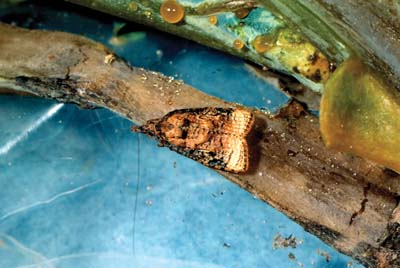
Cabbage webworm, Hellula rogatalis, adult.
(Photographer: P. Choate, University of Florida)
Vegetable crops that are commonly infested by the cabbage webworm include broccoli, cabbage, collards, kale, kohlrabi, mustard, radish, and turnip. Weed hosts include shepherdspurse and purslane. Larvae mine the leaves and eventually produce webbing, resulting in rolled foliage. The growing point may be destroyed in some plants. Insecticidal control is difficult because of the cryptic feeding behavior of the larvae. Insecticides are often applied at least once per week. Plants chosen should be early maturing varieties in order to avoid heavy infestations that occur late in the season.
Images
To save the Web-optimized images shown below to your hard drive:
|
Click to access Display and Print quality images. |
|
Click to access Display and Print quality images. |